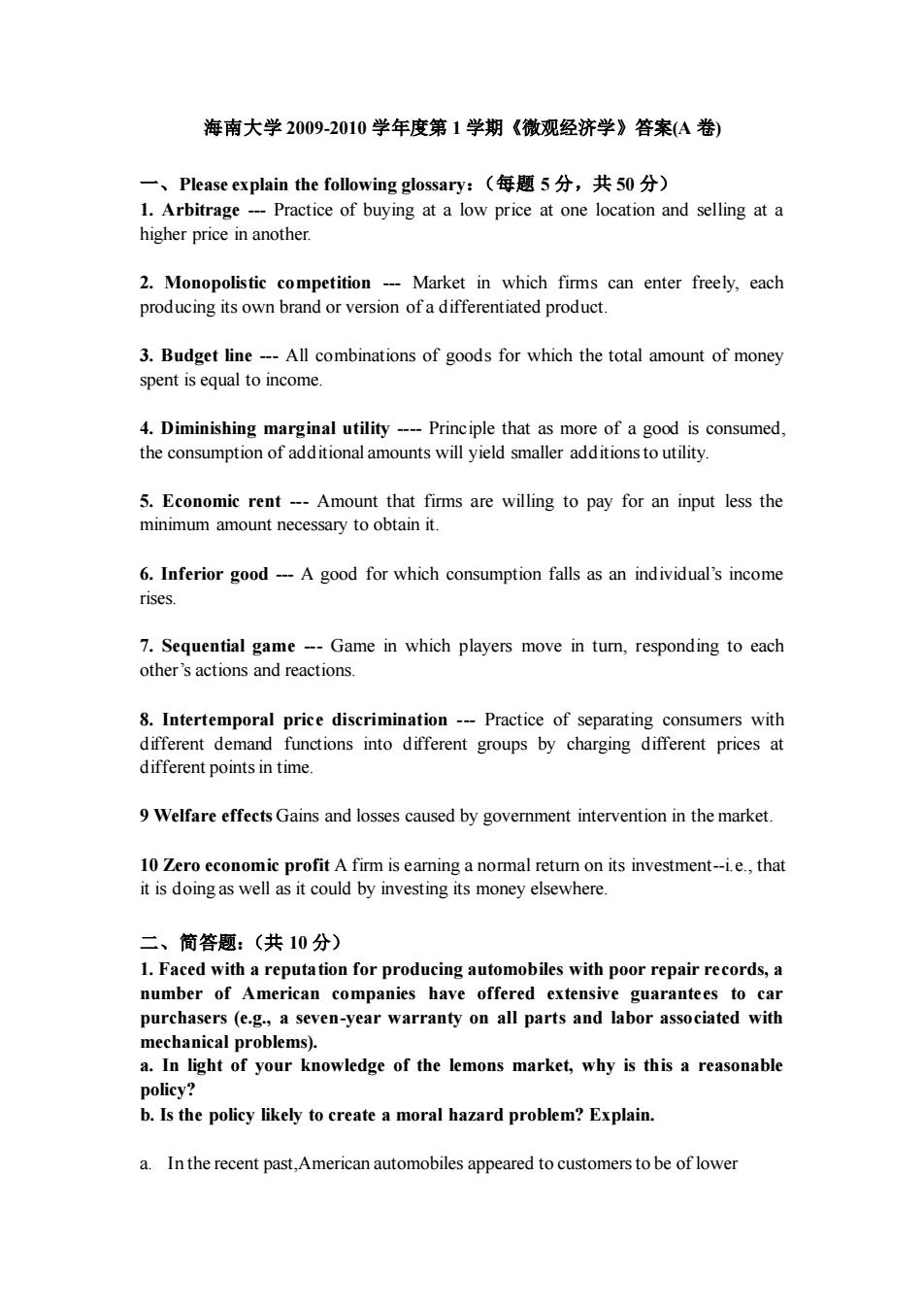正在加载图片...

海南大学2009-2010学年度第1学期《微观经济学》答案(4卷) 一、Please explain the following glossary:(每题5分,共50分) 1.Arbitrage-Practice of buying at a low price at one location and selling at a higher price in another. 2.Monopolistic competition -Market in which firms can enter freely,each producing its own brand or version of a differentiated product. 3.Budget line-All combinations of goods for which the total amount of money spent is equal to income. 4.Diminishing marginal utility-Principle that as more of a good is consumed the consumption of additional amounts will yield smaller additions to utility. 5.Economic rent-Amount that firms are willing to pay for an input less the minimum amount necessary to obtain it. 6.Inferior good-A good for which consumption falls as an individual's income rises. 7.Sequential game-Game in which players move in turn,responding to each other's actions and reactions. 8.Intertemporal price discrimination-Practice of separating consumers with different demand functions into different groups by charging different prices at different points in time. Welfare effeets Gains and losses caused by government intervention in the market 10 Zero economic profit A firm is earning a normal return on its investment-i.e.,that It is doing as well as it could by investing its money elsewhere 二、简答题:(共10分) 1.Faced with a reputation for producing automobiles with poor repair records,a number of Americar companies have offe ered guarantees to ca purchasers (e.g.,a seven-year warranty on all parts and labor associated with mechanical problems). a.In light of your knowledge of the lemons market,why is this a reasonable policy? b.Is the policy likely to create a moral hazard problem?Explain a.In the recent past,American automobiles appeared to customers to be of lower 海南大学 2009-2010 学年度第 1 学期《微观经济学》答案(A 卷) 一、Please explain the following glossary:(每题 5 分,共 50 分) 1. Arbitrage - Practice of buying at a low price at one location and selling at a higher price in another. 2. Monopolistic competition - Market in which firms can enter freely, each producing its own brand or version of a differentiated product. 3. Budget line - All combinations of goods for which the total amount of money spent is equal to income. 4. Diminishing marginal utility - Principle that as more of a good is consumed, the consumption of additional amounts will yield smaller additions to utility. 5. Economic rent - Amount that firms are willing to pay for an input less the minimum amount necessary to obtain it. 6. Inferior good - A good for which consumption falls as an individual’s income rises. 7. Sequential game - Game in which players move in turn, responding to each other’s actions and reactions. 8. Intertemporal price discrimination - Practice of separating consumers with different demand functions into different groups by charging different prices at different points in time. 9 Welfare effects Gains and losses caused by government intervention in the market. 10 Zero economic profit A firm is earning a normal return on its investment-i.e., that it is doing as well as it could by investing its money elsewhere. 二、简答题:(共 10 分) 1. Faced with a reputation for producing automobiles with poor repair records, a number of American companies have offered extensive guarantees to car purchasers (e.g., a seven-year warranty on all parts and labor associated with mechanical problems). a. In light of your knowledge of the lemons market, why is this a reasonable policy? b. Is the policy likely to create a moral hazard problem? Explain. a. In the recent past,American automobiles appeared to customers to be of lower